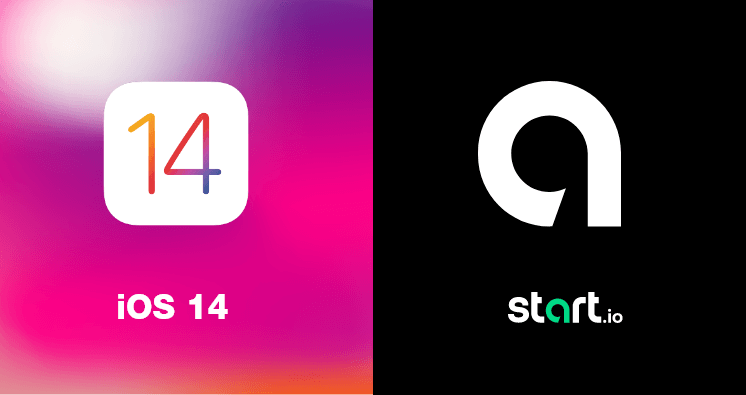In our latest blog post on the burning subject of iOS 14+, we made it clear that in the post-IDFA era, the mobile marketer will prevail. Apple’s App Tracking Transparency (ATT) feature is now live and the key question is what should marketers and app publishers and developers do?
The short answer is update their methods and solutions. Adoption of Apple iOS updates tends to be rapid. The best way to assure your business operations in the ecosystem is to implement and use the changes to your advantage.
The industry has had a couple of months to adapt technologies and address this significant change. At Start.io, we released an updated SDK that presents a whole new set of ID-less targeting features so you can still effectively target your audience.
Mobile App Publishers and Developers
To help improve iOS monetization rates, we encourage mobile app publishers and developers to upgrade to version 4.6.3, which is Start.io’s iOS 14+ compliant SDK, and follow Start.io guidelines for iOS 14+ readiness.
Data drives superior monetization, and yet data doesn’t necessarily get attached to IDs. The ability to segment mobile audiences according to various factors, such as contextual usage of the device, app category and sub-category, time of day, language and many others, is key to driving outstanding performance.
Marketers – Mobile Is and Always Will Be Your Superpower
The limitation of IDFA collection will have an impact on the ability to directly measure campaign ROI. However, mobile still dominates the growth business, and there are valuable tools available to overcome those limitations.
Best practices will change for media buyers and marketers, yet the options are many and advanced. In fact, building an audience with real-time mobile signals (without IDs) can be almost identical. With Start.io’s new SDK, you can target audiences without an ID.
The non-ID campaigns’ activation is based on a clear mapping of the device attributes as mentioned. This set of features will give marketers additional granularity like never before, even in the absence of a unique identifier. Click here to explore our consumer insights and audiences page.
You’ve Got This, and We’ve Got Your Back
Both mobile app publishers and marketers are navigating their next steps in the new era introduced by iOS 14+, and we are all ready for it.
Implementing our new SDK and following our best practices in audience activation and media buying can make your way smooth and easy. In the event that you need any assistance, of course we are here for you. Reach out, and let’s discuss it!
Apple’s App Tracking Transparency (ATT) feature will roll out in early spring, according to the company statement. The move will change the company’s Identifier for Advertisers (IDFA) from opt-out to opt-in across iOS 14+ operating systems. The whole ecosystem that created value to the mobile app publishers and developers faces a tectonic change –bottom line, the mobile marketer will prevail!
Apple’s ATT changes will reduce visibility into essential metrics that show how ads drive conversions, such as engagement and sales. This change will affect how advertisers value mobile advertising.
To help improve iOS monetization rates, we encourage mobile app publishers and developers to upgrade to version 4.6.0, Start.io iOS 14+ compliant SDK, and follow Start.io guidelines for iOS 14+ readiness: https://support.start.io/hc/en-us/articles/360017903540-iOS-14-Readiness-.
Since mid-2020, when Apple introduced this change, the whole ecosystem has been adjusting its products to enable some ad spend visibility. You can learn more about how Google, Facebook, and Twitter are addressing this change.
The main question is how marketers are going to handle this change. Are we going to see a shift in budgets? Should the billboard industry, the print, and radio get a more significant piece of the pay? At Start.io, the answer is crystal clear: mobile marketing will stay the industry front runner – here is why.
The Mobile Marketer Cockpit
The mobile marketer cockpit has changed dramatically in the past few years. The ability to measure every step of the funnel introduced a new world of measurement and ROI optimization. Those changes brought a new marketer with “an unlimited budget” – a marketer that can measure the direct impact of every dollar ad spent. Apple’s change may impact some cockpit features, yet, the mobile device offering is still highly valuable.
Start.io Introduces Hyper-Contextual Mobile Marketing Driven by 1st Party Data
For a pilot, having a weather map of the whole route is essential when planning and navigating, yet it can’t replace the immediate and direct sensors. Start.io’s new iOS SDK launches a new set of features that enable real-time targeting and optimization driven by our SDK 1st Party Data. Marketers running display and video campaigns will shift their focus to the ability to target according to the device’s contextual usage.
Start.io’s SDK will enable optimization according to the local time of the marketer campaign, location (country, district, city, and more), app category and sub-category, app version, ad placement, device language, previous session’s ad engagement, and more.
This set of features will allow marketers to have additional granularity like never before even in the absence of a unique identifier on their campaigns. The mobile device remains a powerful tool for marketers.
Data privacy.
It’s the hottest topic right now, and it’s all thanks to the upcoming changes to Apple’s IDFA.
Apple’s strategic move to boost IDFA data privacy for iPhone users affects everyone in the mobile advertising industry, from ad networks to app developers, digital marketers, in-app advertisers, all the way to consumers who will benefit the most and gain greater control over their online data exposure.
Here at Start.io, we are geared up and ready to handle the challenges that this privacy revolution will bring. And we want to help you thrive in the face of Apple’s turnabout. So let’s start at the beginning.
What is Apple’s privacy change really all about?
Up till now, advertisers have targeted iPhone users with their IDFA, “Identifier for Advertisers” – a unique ID that lets advertisers track and collect the user’s in-app activity in order to target them with relevant ads. According to Apple, every app has an average of six third-party data trackers, all of which track, collect, and monetize its users’ data.
For Apple’s next software release in early spring 2021, the company is instituting a revolutionary change to its tracking policies known as App Tracking Transparency (ATT).
Via ATT, Apple will start requiring that apps and advertisers attain the user’s permission in order to use the IDFA for tracking and ad targeting. Apple’s new privacy policy aims to give app users control over how their data is handled and by whom.
Users can manage their own data tracking permissions, choosing to opt-in or opt-out of data tracking for each individual app. It’s a major step forward for data privacy on the consumer side.
On the other hand, it puts app owners in a tough position. Developers use IDFA to attribute app installs and tie app events to retargeting media across iOS devices. The inability to do this across the board will make it much more difficult to measure campaign performance, target users with relevant ads, and optimize revenues from app monetization.
The ramifications are deep and broad
Google acknowledges that publishers “may see” a palpable impact on their Google ad revenue on iOS once Apple’s policies take effect, due to reduced visibility into performance metrics and measurement.
In addition, Google decided that it will no longer collect and use the IDFA in its own iOS apps for advertising purposes, and will therefore not display the opt-in permissions prompt to users in those apps.
Another player that will take a hard hit is Facebook. The social media giant says that ads that are not personalized are able to achieve only half the value of personalized ads monetized in Audience Network. Bottom line? Facebook could lose billions in the next quarter when Apple’s ATT policy gets going.
Apple offers an alternative
Of course, Apple is well aware of the obstacle the new IDFA policy will be for app developers and advertisers to measure, analyze and attribute user data for all-important optimization and monetization activity. So it has introduced its own attribution solution. Introducing SKAdNetwork.
While SKAdNetwork does partially remedy the gap, what it doesn’t do is to provide the level of granularity that platforms currently offer to mobile marketers. Here are the main limitations of SKAdNetwork as an alternative solution:
- ROI & LTV: The available measurements after app install offered by SKAdNetwork are way below optimal in terms of the window available for measurement and the granularity level.
- Data granularity: The data presented is minimal, restricted only to campaign level. In addition, the data only covers 100 campaigns for each network and each app.
- Delay with postback: A minimum of 14-hour delay will occur between installs and reporting. Real time, rapid optimization is therefore much harder to do.
- Risk of increased ad fraud: The SKAdNetwork may make it easier for fraudulent advertisers to create fake traffic, as well making it more difficult to track fraudulent ads and advertisers.
- No support for attribution other than downloads: Deep linking is not supported by SKAdNetwork, and only downloads can be attributed, which makes it much harder to conduct accurate attribution activity.
What else you can do
Clearly, the industry is bracing itself for the impact once the new IDFA changes kick in. Snap Inc, for example, recently stated that there will be a risk of interruption to demand, and the company has been preparing for a future far more focused on first-party data.
No matter how big or small, every player in the mobile app advertising industry must prepare for the upcoming IDFA changes, and here are some ways you can:
- Recalibrate for long-term strategies: Developers must start to consider how their conversion architecture and user data strategy must adapt in order to support long-term value for their advertisers.
- Shifting budgets to Android: Many companies are moving more budgets to Android, out of range of the fallout on iOS.
- Pivot to contextual targeting: Change your mindset from targeting at the individual user level and rather towards a more subtle and nuanced contextual targeting.
- Change your approach to attribution: Move away from 1:1 attribution methodologies and towards probabilistic modeling approaches with the help of existing MMPs (mobile measurement platforms).
- Optimize your permissions request: Convincing users to give you permission to track their IDFA in an era of App Tracking Transparency is critical. Collaborate with your marketing department to craft effective messaging for your opt-in request.
Your partner, always
At Start.io, we are no strangers to the dynamic shifts happening all the time in the mobile app advertising and monetization industry. And that’s true today, with the IDFA changes on the horizon.
We’ve been working hard to ensure that Start.io is SKAdnetwork compliant, so that we can be in the best position to partner with you during and beyond the transition to ATT. Need assistance and guidance as the release of iOS14 approaches? Don’t hesitate to contact us today.



